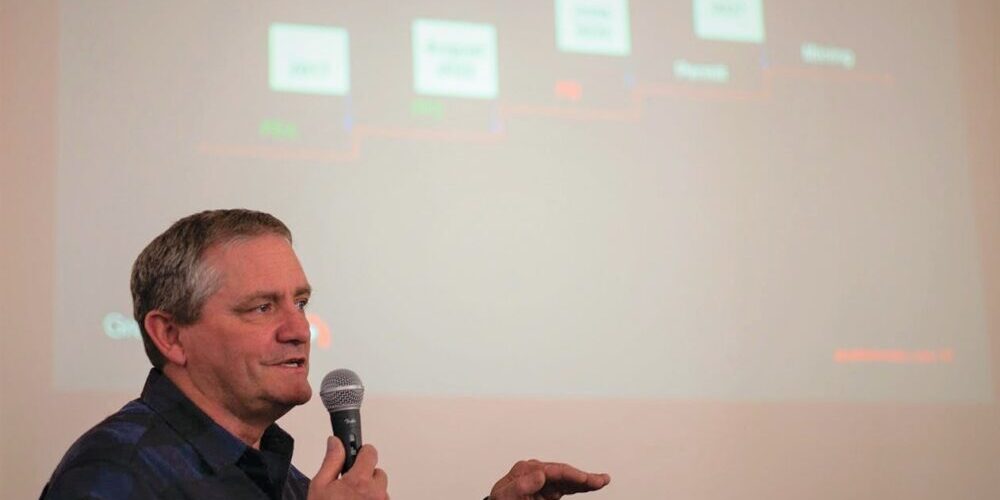A representative from a company seeking to establish a graphite mine in the Kigluaik Mountains north of Nome held a community meeting last week to discuss what is happening with the project, its future impact on the city and port, and employee needs.
The meeting was held on April 20 at Old St. Joe’s Church.
Graphite One Alaska, an American subsidiary of Canada’s Graphite One corporation, wants to develop a pit mine at Graphite Creek. It would be the largest graphite mine in the United States.
Mike Schaffner is the Senior Vice President at Graphite One Alaska. He said the company’s pre-feasibility study that was completed in October 2022 identified a target of 53,000 tons that could be sent to market each year.
But now that the initial study is complete, Schaffner said his company believes the amount of graphite needed by the market is likely to grow.
“By the time we completed it, it was apparent that the market is going to need much more graphite,” Schaffner said.
Graphite is key to the production of battery anodes. A secondary Graphite One treatment plant, designed to produce lithium-ion battery anode materials on a commercial scale for the U.S. market, is planned for construction in Washington state.
The preliminary study has shown a 24-year life span for the mine. After hearing the presentation from Schaffner last week, Nome Mayor John Handeland said he thinks there might be more graphite than expected at the site.
“With further drilling we could very likely extend that for another decade or two,” Handeland said.
The study forecasts that by 2025 total graphite demand could grow to 4.53 million tons, a 59% increase from 2020.
According to Schaffner, a host of jobs – including those earmarked for residents of Nome and surrounding communities – will be available starting this summer.
We’ll be using about 120 people this summer,” Schaffner said. “Of that, we hope to hire between 20 and 35 from the local area, positions from driller helpers, laborers to equipment operators to camp cooks. Over the next three years that would remain about the same, and then if everything goes well, we would hope to start ramping up during construction in 2027 or 2028.”
Graphite One took control of federal claims on the property, through a long-term lease with Kougarok LLC in 2015. Graphite One has 120 Alaska Mining Claims at 160 acres each.
If the mine is approved, Schaffner said he is hopeful the graphite leaving Nome would bring a substantial amount of barge traffic to the port by 2029. He added that graphite would be shipped in sealed containers to avoid dust. The company aims to ship up to 10,000 tons of concentrate at a time, utilizing about 20 barges a year.
Nome Port Director Joy Baker says the port can handle the initial projections of outbound graphite.
“I could see the Port of Nome and the shipping companies being able to export a portion of the graphite products southbound,” Baker said. “Then. as their mine got up to speed, they could easily be bringing up vessels just to take products out, to export volumes that they anticipate reaching annually of 200,000 tons”
Graphite One Alaska plans to operate year-round. There is no current road access to the property.
The pre-feasibility study says a year-round road connected to either the Teller or Taylor highway is considered the most suitable transport option from the mine site. However, the presence of two threatened seal species in the Imuruk Basin, and concerns regarding potential impacts to subsistence, are worrisome to one community.
Gilbert Tocktoo, the president of the Native Village of Brevig Mission, said he feels that most residents in his village are against the mine. He says water that might be used for mine operations poses a serious risk to the environment.
“If that contaminated water hits any of our streams or creeks, or rivers, that could kill off our salmon and sea mammals that use the basin for migratory routes or spawning,” Tocktoo said.
The mayor of Teller, Blanch Okbaok-Garnie, said she was skeptical of Graphite One putting in any roads at first, but changed her mind when she observed that it might provide more access to subsistence hunting grounds in the future.
“I think if there were road improvements that would help our community,” Okbaok-Garnie said. “Right now we’re wishing a road would be open.”
Graphite One’s next step is a full feasibility study and fieldwork, which is expected to be complete by the end of 2024. At that point Graphite One would begin applying for permits, with an aim to start construction in 2027. According to the company, research is currently underway regarding wetlands, water and air quality, aquatic resources, and the marine environment at or near the mine site.
Image at top: Graphite One Alaska’s Mike Schaffner speaks to Nome residents about the proposed mine on Thursday, April 20. Photo courtesy of The Nome Nugget newspaper.




